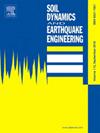Optimal design and performance evaluation of a tuned inertial damper considering soil-structure interaction effects
IF 4.2
2区 工程技术
Q1 ENGINEERING, GEOLOGICAL
引用次数: 0
Abstract
The tuned inertial damper (TID) is an inerter-based damper that has been widely used to reduce the vibration of structures in seismic engineering. Due to the mass amplification effect of inertial capacity, it has become an effective substitute for conventional tuned mass damper (TMD). The design parameters in the TID are generally H2-optimised, based on the assumption that the rigid structural foundation is excited by a stochastic white noise. However, the effect of soil-structure interaction (SSI) and the frequency dependence of the power spectral density model for stochastic ground motion are worth to be considered in the optimisation. In this regard, this paper establishes the equations of motion control for a single-degree-of-freedom (SDOF) structure equipped with a TID considering the SSI effect, and derives the mean-square value of the response of the SSI-SDOF-TID system with seismic excitation described by filtered Kanai-Tajimi (K-T) spectrum. Numerical optimisation is carried out by using a novel Nutcracker Optimisation Algorithm (NOA). The displacement, velocity and acceleration response reduction ratios of the concentrated mass supported by different soil conditions, as well as the optimal stiffness ratios and damping ratios of the corresponding TIDs, are compared to demonstrate the necessity of considering the SSI effect. Finally, the time-history responses of displacement, velocity, and acceleration of SSI-SDOF-TID system under artificial and natural seismic waves are analysed in soft soil conditions, and compared with SSI-SDOF systems. The parameter analysis shows that the optimal parameters of TID obtained for soft soil conditions with the same objectives are smaller than those of dense and medium soils, and the vibration control effect is the worst. The parameters of TID obtained from the optimisation of the same soil condition will be overestimated if the external excitation is simplified to white noise. The time-history response analysis of seismic waves in soft soil shows that the TID obtained by considering SSI has better vibration control performance.
求助全文
约1分钟内获得全文
求助全文
来源期刊

Soil Dynamics and Earthquake Engineering
工程技术-地球科学综合
CiteScore
7.50
自引率
15.00%
发文量
446
审稿时长
8 months
期刊介绍:
The journal aims to encourage and enhance the role of mechanics and other disciplines as they relate to earthquake engineering by providing opportunities for the publication of the work of applied mathematicians, engineers and other applied scientists involved in solving problems closely related to the field of earthquake engineering and geotechnical earthquake engineering.
Emphasis is placed on new concepts and techniques, but case histories will also be published if they enhance the presentation and understanding of new technical concepts.
 求助内容:
求助内容: 应助结果提醒方式:
应助结果提醒方式:


